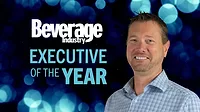CEO Roundtable: A Year In Review
CEO Roundtable:
A Year In Review
Beverage companies dealt with a number of challenges in 2005, adding natural disasters, increased raw materials costs and soaring energy prices to the already daunting task of keeping up with consumer preferences. We asked four industry leaders, each representing a different beverage category, to tell us about their year and the factors that most influenced their businesses. Participants include: Gil Cassagne, president and chief executive officer at Cadbury Schweppes Americas Beverages, Plano, Texas; Richard Sands, chairman and chief executive officer at Constellation Brands, Fairport, N.Y.; Don Vultaggio, chairman of Ferolito Vultaggio & Sons, Lake Success, N.Y.; and Jim Koch, founder and chairman of Boston Beer Co., Boston.
Q: How would you describe the past year in your
beverage category?
Cassagne: Challenging,
but rewarding. We’ve bucked the downward trend of full-calorie CSDs
by focusing on Dr Pepper and have grown the brand for two years straight.
Additionally, our diet and non-carbonated brands like Diet Dr Pepper and
Snapple are growing. We believe this is a significant achievement for a
company that is only one year old, and we see this as an indication that
our strategies are working.
Sands: Dynamic. In fiscal
2005 our performance exceeded expectations and we set records for annual
sales, net income, earnings per share and other metric measures, and we
topped the $4 billion mark in net sales for the first time in the
company’s 60-year history. The breadth of
our portfolio, our distribution scale in our core markets of the United
States, United Kingdom, Australia and New Zealand, combined with our
acquisition activities, new product development initiatives and efficiency
improvements all contributed to our positive momentum and true growth.
Because we have breadth and scale, when one category
is a bit soft, one or more is performing strong, which has provided
stability and consistency in our results as we continue to grow. Our goal
has been an annual increase of 15 percent in net sales, with approximately
half coming from our existing portfolio and half from the acquisitions and
business partnerships we make. Achieving that objective, which we have done
several times, means that we will double the size of the company every five
years. Mathematically, that will become more of a challenge in the
future due to the company’s now significant size.
While the overall spirits and beer categories are
fairly well consolidated on a global basis, wine is not. Even though we are
the largest wine producer in the world, we only have about 4.5 percent of
the global market share. We look at all beverage alcohol opportunities and
our current emphasis is on mid-premium and premium spirits, although we
will act on wine opportunities if they represent a good fit for
Constellation Brands.
Vultaggio: Overall [there
has been] good growth in the category. Astonishing growth for our company.
Koch: Our category is
American craft beer and it has been another strong year for our category.
For the second year in a row, craft beer is the star of the beer industry.
It looks like growth is going to be at least 5 percent again this year,
after growing 7 percent last year. You’ve got people getting excited
about wine and spirits growth, which are in the 3 and 4 percent range, so
in some ways the star of alcohol beverage growth has been craft beer.
Q: What have been the biggest factors (positive or
negative) that have influenced how the category has performed in 2005?
Sands: There have
been several. One would be the consumer movement away from domestic beer to
wine, spirits and imported beer in the United States. Our imported beer
portfolio, with excellent offerings such as Corona, Corona Light, Pacifico,
Modelo Especial, Negra Modelo, St. Pauli Girl and Tsingtao, is well
positioned and has posted healthy growth. Our breadth of New World wine
offerings provides consumers with excellent quality and value at all
points, as does our excellent Old World wine portfolio from Italy and
France. We have terrific value brands in the spirits category, and
we’re continually strengthening our premium spirits portfolio.
Another factor would be that we continue to see
consumers trading up to higher price points in wine. We are well situated
to give consumers what they desire in premium and luxury wine, so this
trend is one we like to see.
International consolidation continues among suppliers,
distributors/wholesalers and retailers. As consolidation continues, it is
more important than ever for companies like Constellation Brands to
maintain its clout via portfolio breadth and operational scale.
According to all of the research we can find on the
subject, consumers in our core markets want choice. We can readily offer
choice to consumers because our decentralized structure allows our
operating divisions to remain close to their customers and consumers, and
as such they are nimble in their response to consumer trends. New wines,
spirits and line extensions move quickly from concept to market, allowing
us to tap into the front end of consumer trends.
Demand for New World wine continues to increase, and
California, New Zealand and Australian wine is riding the crest of that
wave.
We’re still assessing the impact of higher
energy costs (globally), natural disasters (U.S.), terrorism (London
bombings in July) and international consumer confidence (waning in the
United Kingdom and wavering in the United States). However, we’ve
found there is always demand for our products. We’ve hedged
some of the energy cost increases, but we’re like everyone else who
had not envisioned the recent dramatic spike in fuel costs.
Cassagne: Consumers made
their voices heard loud and clear in 2005. I think the activity
you’ve been seeing in the category, like
new product introductions and a focus on diets, are the result of a renewed
emphasis on giving consumers what they want, not what we think they want.
The greatest example at CSAB is the launch of Cherry Vanilla Dr Pepper and
7UP Plus in 2004. This year both brands really took off with consumers.
Diet Cherry Vanilla Dr Pepper is one of our most successful product
launches in 10 years, and 7UP Plus has more than doubled its volume.
Vultaggio: Positive
influences include quality new product introductions, new customers looking
for healthier beverages, and increased consumption by existing customers.
The negative influences are negative publicity due to soft drinks
attributing to childhood obesity.
Koch: We are seeing
the continuing consumer interest in beers with more flavor, more variety,
and more dignity, maybe. A craft beer is a quite different experience than
a mass domestic beer. We have a different image, we have different styles
of beer than the beers that characterize the mass domestic category. Having
a craft beer isn’t just a refreshment beverage. People are getting
flavor, variety and some history, and they’re getting something you
can talk about.
Q: What have been the most significant factors
affecting your own business this year?
Vultaggio: The proliferation of our green tea portfolio. As the leader in
green tea in the beverage industry we added five new green tea flavors this
year; Peach Green Tea, Blueberry Green Tea, Cran-Apple Green Tea,
Pomegrante Green Tea and Diet Decaf Green Tea, giving us the broadest
portfolio of Green Tea in the industry. This equated to tremendous growth
for the company.
Cassagne: We continue
to drive above-industry growth rates in both our North American and Mexican
businesses, and we’ve done it consistently for 22 months.
However, external factors on everything from oil to
transportation, PET and resin, natural gas and glass continue to be
difficult hurdles to overcome. And since Hurricanes Katrina and Rita,
it’s only gotten more challenging. No one could have anticipated
we’d be seeing $3 a gallon gas this year.
Sands: The integration of, and growing momentum for the Robert Mondavi
portfolio in the United States and United Kingdom; continued strong demand
for our imported beer portfolio in the United States; continued strength in
the branded wine category; and growth in secondary markets around the
world.
Koch: The craft
category has grown, and Sam Adams has always been the leader of the craft
category, so we’re getting increased interest from wholesalers and
retailers who see the excitement around Sam Adams and the whole category.
Q: If you could wish for one thing during the upcoming
year for your business, what would it be?
Cassagne: Another year of growth for our CSD and non-carbonated
brands, and lower oil prices.
Koch: Another
excellent hop crop in Bavaria. That would be good. And second, I’d
like to see a return to growth for the entire beer category, including the
mass domestics. It would be good for all of us to see Bud, Miller and Coors
growing again, especially if it was accompanied by enhanced appreciation of
beer’s role in a healthy lifestyle.
Vultaggio: Increased
production capacity.
Sands: More of the
same consistent growth pattern that we’ve been experiencing that has
resulted in increased shareholder value from true growth.
Q: Looking into 2006, what do you see ahead for your
beverage category?
Cassagne: I see
continued segmentation in the industry. People are looking for beverages
with functional solutions like flavored waters, and this category will
continue to expand. New age beverages will continue to grow, and the diet
category will rebound. I also think the decline of full-calorie beverages
has been greatly exaggerated, and I see a resurgence of indulgent beverages
in general, contrary to current trends.
Koch: I see the
continuing market share battles among the big brewers, either being
resolved or continuing to trouble the entire category. I am a believer that
consumers will continue to trade up because they’ve been doing it for
30 years with beer. I see continuing vitality at the higher end of the beer
business.
Vultaggio: A
continuing shift away from soft drinks to healthier beverages.
Sands: Continued
consolidation by suppliers, distributors/wholesalers and retailers.
Opportunities to expand the categories around the world, and more and new
opportunities to provide consumers with the beverage alcohol variety they
seek. BI
Looking for a reprint of this article?
From high-res PDFs to custom plaques, order your copy today!





